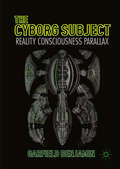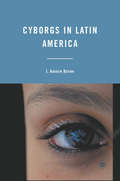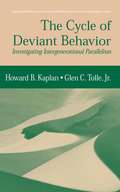- Table View
- List View
Cybertypes: Race, Ethnicity, and Identity on the Internet
by Lisa NakamuraFirst published in 2002. Routledge is an imprint of Taylor & Francis, an informa company.
Cybertypes: Race, Ethnicity, and Identity on the Internet
by Lisa NakamuraFirst published in 2002. Routledge is an imprint of Taylor & Francis, an informa company.
CyberUnion: Empowering Labor Through Computer Technology
by Arthur B ShostackKey players in organized labour in the USA and abroad are busy modernizing their communications and making creative and effective use of computers and other technology. The author of this book argues that the road to CyberUnion has begun and that those unions are ensuring a future strength.
CyberUnion: Empowering Labor Through Computer Technology
by Arthur B ShostackKey players in organized labour in the USA and abroad are busy modernizing their communications and making creative and effective use of computers and other technology. The author of this book argues that the road to CyberUnion has begun and that those unions are ensuring a future strength.
Cyberwarfare: Threats to Critical Infrastructure (Palgrave Studies in Cybercrime and Cybersecurity)
by Kristan StoddartThis book provides a detailed examination of the threats and dangers facing the West at the far end of the cybersecurity spectrum. It concentrates on threats to critical infrastructure which includes major public utilities. It focusses on the threats posed by the two most potent adversaries/competitors to the West, Russia and China, whilst considering threats posed by Iran and North Korea. The arguments and themes are empirically driven but are also driven by the need to evolve the nascent debate on cyberwarfare and conceptions of ‘cyberwar’. This book seeks to progress both conceptions and define them more tightly. This accessibly written book speaks to those interested in cybersecurity, international relations and international security, law, criminology, psychology as well as to the technical cybersecurity community, those in industry, governments, policing, law making and law enforcement, and in militaries (particularly NATO members).
Cyborg Babies: From Techno-Sex to Techno-Tots
by Robbie Davis-Floyd Joseph DumitFirst Published in 1998. Routledge is an imprint of Taylor & Francis, an informa company.
Cyborg Babies: From Techno-Sex to Techno-Tots
by Robbie Davis-Floyd Joseph DumitFirst Published in 1998. Routledge is an imprint of Taylor & Francis, an informa company.
Cyborg Cinema and Contemporary Subjectivity
by S. ShortThis book breaks new ground in providing an in-depth critical assessment of cyborg cinema, arguing that it remains one of the most intriguing and provocative cycles to have emerged in contemporary screen culture. Tracing the cinematic cyborg's transition over the last two decades and evaluating the theoretical significance attributed to this figure, it asks what relevance the cyborg continues to have in terms of understanding human identity, our relationship to technology, and to one another.
Cyborg Citizen: Politics in the Posthuman Age
by Chris Hables GrayThe growing synergy of humans and technology--from dialysis to genetically altered foods to PET scans--is transforming how we view our minds and our bodies. But how has it changed the body politic? How can we forge a society that protects the rights of human and cyborg alike?The creator of the cult classic Cyborg Handbook, Chris Hables Gray, now offers the first guide to "posthuman" politics, framing the key issues that could threaten or brighten our technological future. For good or ill, politics has already been cyborged in ways that touch us all: On-line voting promises to change who participates. Wars are won on video screens. Biotechnological advances-- cloning, sexual prostheses, gene patents--are redefining life, death, and family in ways that strain the social contract. In the face of these advances, visions of the cyborg future range from the utopian to the nightmarish, from a spiritual super-race transcending the body's confines to a soulless Borg consuming human individuality.Only with a broad, historically rich and ethically grounded understanding of these issues, Gray argues, can we combat the threats to our freedom and even our survival. A work of vision and imagination, Cyborg Citizen lays the groundwork for the participatory evolution of our society.
Cyborg Citizen: Politics in the Posthuman Age
by Chris Hables GrayThe growing synergy of humans and technology--from dialysis to genetically altered foods to PET scans--is transforming how we view our minds and our bodies. But how has it changed the body politic? How can we forge a society that protects the rights of human and cyborg alike?The creator of the cult classic Cyborg Handbook, Chris Hables Gray, now offers the first guide to "posthuman" politics, framing the key issues that could threaten or brighten our technological future. For good or ill, politics has already been cyborged in ways that touch us all: On-line voting promises to change who participates. Wars are won on video screens. Biotechnological advances-- cloning, sexual prostheses, gene patents--are redefining life, death, and family in ways that strain the social contract. In the face of these advances, visions of the cyborg future range from the utopian to the nightmarish, from a spiritual super-race transcending the body's confines to a soulless Borg consuming human individuality.Only with a broad, historically rich and ethically grounded understanding of these issues, Gray argues, can we combat the threats to our freedom and even our survival. A work of vision and imagination, Cyborg Citizen lays the groundwork for the participatory evolution of our society.
Cyborg Conception: Cultural and Critical Responses to Solo Motherhood by Choice
by Grace HaldenThis book considers the growing popularity of solo motherhood via gamete donation and how this type of “cyborg conception” is narrated in medicine, bioethics, fiction, and memoir. It identifies solo mothers as radical women who exist in a space beyond binarity (male/female dual-rearing dynamic) and heteronormative discourse; solo mothers represent, among other diverse family constructions (such as same-sex couples and throuples), a critical intervention in the dominant narrative of the nuclear family which defines the “ideal” reproductive model. This book combines memoir and scholarly research to present a deeply nuanced and rigorous overview of the solo motherhood phenomenon.
Cyborg Mind: What Brain–Computer and Mind–Cyberspace Interfaces Mean for Cyberneuroethics
by Calum MacKellarWith the development of new direct interfaces between the human brain and computer systems, the time has come for an in-depth ethical examination of the way these neuronal interfaces may support an interaction between the mind and cyberspace. In so doing, this book does not hesitate to blend disciplines including neurobiology, philosophy, anthropology and politics. It also invites society, as a whole, to seek a path in the use of these interfaces enabling humanity to prosper while avoiding the relevant risks. As such, the volume is the first extensive study in cyberneuroethics, a subject matter which is certain to have a significant impact in the 21st century and beyond.
The Cyborg Subject: Reality, Consciousness, Parallax
by Garfield BenjaminThis book outlines a new conception of the cyborg in terms of consciousness as the parallax gap between physical and digital worlds. The contemporary subject constructs its own internal reality in the interplay of the Virtual and the Real. Reinterpreting the work of Slavoj Žižek and Gilles Deleuze in terms of the psychological and ontological construction of the digital, alongside the philosophy of quantum physics, this book offers a challenge to materialist perspectives in the fluid cyberspace that is ever permeating our lives. The inclusion of the subject in its own epistemological framework establishes a model for an engaged spectatorship of reality. Through the analysis of online media, digital art, avatars, computer games and science fiction, a new model of cyborg culture reveals the opportunities for critical and creative interventions in the contemporary subjective experience, promoting an awareness of the parallax position we all occupy between physical and digital worlds.
Cyborg Theatre: Corporeal/Technological Intersections in Multimedia Performance (Performance Interventions)
by J. Parker-StarbuckThis book articulates the first theoretical context for a 'cyborg theatre', metaphorically integrating on-stage bodies with the technologized, digitized, or mediatized, to re-imagine subjectivity for a post-human age. It covers a variety of examples, to propose new theoretical tools for understanding performance in our changing world.
Cyborg-TV: Genetik und Kybernetik in Fernsehserien (Serienkulturen: Analyse – Kritik – Bedeutung)
by Sven StollfußIn Zeiten hoher Forderungen nach Optimierung und Leistungssteigerung scheint der Mensch im 21. Jahrhundert erneut in der Krise. Als Seismograf und Motor kritischer, kultureller Selbstbeschreibung wird in diesem Zusammenhang die TV-Serie auf ihr Einwirken auf gesellschaftliche Selbstverständigungsdiskurse untersucht. Mit Analysen zu Serien wie u.a. Orphan Black und Continuum oder auch Dark Angel und The Six Million Dollar Man arbeitet das Buch Kybernetik und Genetik als Bestandteile einer gemeinsamen Populärkultur der computertechnologischen Informatisierung unter Voraussetzung eines politisierenden Potentials des kybernetischen Körpers innerhalb der nordamerikanischen Fernsehserienkultur auf.
Cyborg werden: Möglichkeitshorizonte in feministischen Theorien und Science Fictions (Gender Studies)
by Dagmar FinkCyborgs waren ursprünglich ein Produkt technomilitärischer Imagination mit dem Ziel, die Beschränkungen des menschlichen Körpers zu überwinden. Als kybernetischer Organismus sind Cyborgs tatsächlich weder Mensch noch Maschine - und doch beides zugleich. Gerade dies macht sie für queer_feministische Spekulationen attraktiv, die Dualismen als Fundament von Herrschaftslogiken kritisieren. Dagmar Fink fragt danach, wie Cyborgs Dualismen zur Implosion bringen, wie sich mit Cyborgs Vorstellungen von Differenz jenseits von Dualismen entwickeln lassen und wie queer_feministische Geschichten in Theorien und Science Fictions unsere Möglichkeitshorizonte erweitern.
Cyborgs and Barbie Dolls: Feminism, Popular Culture and the Posthuman Body
by Kim ToffolettiBringing a lively and accessible style to a complex subject, "Cyborgs and Barbie Dolls" explores the idea of the 'posthuman' and the ways in which it is represented in popular culture. Toffoletti explores images of the posthuman body from goth-rocker Marilyn Manson's digitally manipulated self-portraits to the famous TDK 'baby' adverts, and from the work of artist Patricia Piccinini to the curiously 'plastic' form of the ubiquitous Barbie doll, controversially rescued here from her negative image. Drawing on the work of thinkers including Baudrillard, Donna Haraway and Rosi Braidotti, "Cyborgs and Barbie Dolls" explores the nature of the human - and its ambiguous gender - in an age of biotechnologies and digital worlds.
Cyborgs and Barbie Dolls: Feminism, Popular Culture and the Posthuman Body
by Kim ToffolettiBringing a lively and accessible style to a complex subject, 'Cyborgs and Barbie Dolls' explores the idea of the 'posthuman' and the ways in which it is represented in popular culture. Toffoletti explores images of the posthuman body from goth-rocker Marilyn Manson's digitally manipulated self-portraits to the famous TDK 'baby' adverts, and from the work of artist Patricia Piccinini to the curiously 'plastic' form of the ubiquitous Barbie doll, controversially rescued here from her negative image. Drawing on the work of thinkers including Baudrillard, Donna Haraway and Rosi Braidotti, 'Cyborgs and Barbie Dolls' explores the nature of the human - and its ambiguous gender - in an age of biotechnologies and digital worlds.
Cyborgs@Cyberspace?: An Ethnographer Looks to the Future
by David HakkenArguing that humans have always been technological as well as cultural beings, David Hakken calls for a fundamental rethinking of the traditional separation of anthropology and technical studies. Drawing on three decades of research on contemporary technological societies, this book outlines a fresh way of thinking about technology and offers an ethical and political response to the challenge of truly living as "cyborgs" in the age of cyberspace.
Cyborgs@Cyberspace?: An Ethnographer Looks to the Future
by David HakkenArguing that humans have always been technological as well as cultural beings, David Hakken calls for a fundamental rethinking of the traditional separation of anthropology and technical studies. Drawing on three decades of research on contemporary technological societies, this book outlines a fresh way of thinking about technology and offers an ethical and political response to the challenge of truly living as "cyborgs" in the age of cyberspace.
Cyborgs, Ethics, and The Matrix: Simulations of Sex and Gender (Palgrave Studies in (Re)Presenting Gender)
by Rebecca GibsonThe Matrix (Lana Wachowski and Lilly Wachowski 1999) has permeated our cultural consciousness for two decades, working its way into such common parlance as “a glitch in the Matrix,” and the idea of taking the Red Pill. With the release of the fourth movie, The Matrix Resurrections (Lana Wachowski 2021), and the confirmation of the franchise being a metaphor for gender transition, this book examines how the entire franchise contributes to the discourse on sex and gender, and how it has been instrumental in propelling the creation of new types of cyborg technology. This book centers on the main philosophical theme of The Matrix, know thyself, and relate it to the quest for authenticity which creates our identities—be they human, or human “enough”—as we move through the world.
Cyborgs in Latin America
by J. BrownA PDF version of this book is available for free in open access via the OAPEN Library platform, www.oapen.org . Cyborgs in Latin America explores the ways cultural expression in Latin America has grappled with the changing relationships between technology and human identity.
The Cycladic and Aegean Islands in Prehistory
by Ina BergThis textbook offers an up-to-date academic synthesis of the Aegean islands from the earliest Palaeolithic period through to the demise of the Mycenaean civilization in the Late Bronze III period. The book integrates new findings and theoretical approaches whilst, at the same time, allowing readers to contextualize their understanding through engagement with bigger overarching issues and themes, often drawing explicitly on key theoretical concepts and debates. Structured according to chronological periods and with two dedicated chapters on Akrotiri and the debate around the volcanic eruption of Thera, this book is an essential companion for all those interested in the prehistory of the Cyclades and other Aegean islands.
The Cycladic and Aegean Islands in Prehistory
by Ina BergThis textbook offers an up-to-date academic synthesis of the Aegean islands from the earliest Palaeolithic period through to the demise of the Mycenaean civilization in the Late Bronze III period. The book integrates new findings and theoretical approaches whilst, at the same time, allowing readers to contextualize their understanding through engagement with bigger overarching issues and themes, often drawing explicitly on key theoretical concepts and debates. Structured according to chronological periods and with two dedicated chapters on Akrotiri and the debate around the volcanic eruption of Thera, this book is an essential companion for all those interested in the prehistory of the Cyclades and other Aegean islands.
The Cycle of Deviant Behavior: Investigating Intergenerational Parallelism (Longitudinal Research in the Social and Behavioral Sciences: An Interdisciplinary Series)
by Howard B. Kaplan Glen C. Tolle Jr.To conduct this study on criminal and antisocial behavior, the authors devoted years to collecting data from a large community sample of first-generation subjects. Data were garnered throughout their early adolescence, twenties, and thirties as well as from these first-generation subjects’ biological children during their own early adolescence. The results of these studies have profound implications for future research and methodology on deviant behavior.


















